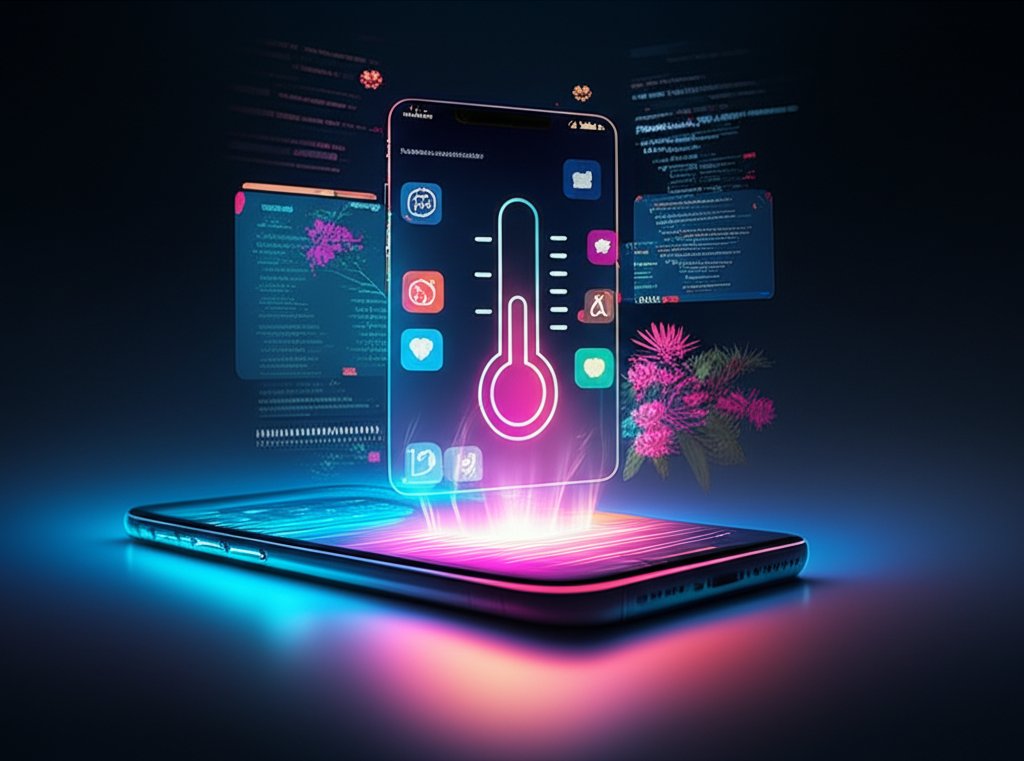Imagine crafting an enterprise mobile app for facilities management. Users need to report temperature fluctuations in office spaces. Can you really rely on their smartphones to provide accurate room temperature readings? Understanding the capabilities (and limitations) of mobile devices is crucial for reliable application design and data interpretation in enterprise mobile app development.
At a glance:
- Learn about the sensor limitations of smartphones for measuring room temperature.
- Discover alternative methods for approximating room temperature data using readily available APIs.
- Understand the best practices for incorporating temperature data into your enterprise mobile app while setting realistic user expectations.
- Explore how to leverage external sensors and integrations for more accurate environmental monitoring.
Why Your Phone Isn’t a Pocket Thermostat (and What To Do About It)
The cold, hard truth: your smartphone doesn’t have a dedicated room temperature sensor. While it does contain temperature sensors, these are primarily for monitoring the internal temperature of components like the CPU and battery. These internal readings are crucial for preventing overheating and ensuring optimal device performance; they’re not designed to measure the ambient temperature of a room. So, what explains the many “room temperature” apps available? And how can we use them in enterprise contexts?
Phone temp: Fact or Fiction? – the pillar article explores this topic in detail. It sets the stage for making smart choices in your enterprise mobile app approach.
Understanding Your Options: How Temperature Apps Work
Most apps that claim to measure room temperature rely on data interpolation and external weather services. They use your phone’s location (via GPS or network data) to pull temperature information from nearby weather stations. Some try to get crafty by using the battery sensor’s temperature for an approximate reading. Let’s break down the common approaches:
- Location-Based Weather Data: The most common and reliable method. These apps query weather APIs based on the device’s location and display the reported temperature for that area. Example: Thermometer++ pulls data from multiple weather services to avoid outlier influences.
- Internal Sensor Approximation: Some apps attempt to correlate battery temperature with the surrounding environment. This method is highly unreliable due to the significant influence of device usage and internal heat generation. Example: an app that uses both built-in hardware sensors (like battery temperature) and location-based weather data.
- User Calibration: A few apps allow users to calibrate the temperature reading based on a known accurate thermometer. This can marginally improve accuracy, but it’s still subject to limitations. Example: An app that requests that users calibrate the temperature by using a precise external analog thermometer.
Building Reliable Temperature Features: Enterprise Considerations
So, how do you incorporate temperature information into your enterprise mobile app without misleading users? Here’s a framework:
- Clearly Communicate Limitations: Be upfront about how the app determines temperature and its potential inaccuracies. A disclaimer stating, “Temperature data is based on external weather services and may not reflect the exact temperature of your current location” can prevent user frustration.
- Prioritize External Data Sources: Reliably use trusted weather APIs over internal sensor hacks. Services like OpenWeatherMap, AccuWeather, and Weatherbit offer robust APIs with varying levels of detail and accuracy.
- Implement Data Validation: Cross-reference data from multiple weather sources to identify and filter out outliers or inaccurate readings. Some apps use special algorithms in order to work with multiple weather services at the same time.
- Provide Contextual Information: Display the source of the temperature data (e.g., “Weather station: [Station Name]”) and the time the data was last updated.
- Offer Calibration Options (with Caveats): If you choose to include a calibration feature, emphasize that it’s a temporary adjustment and not a guarantee of accuracy.
Practical Example: A Facilities Management App
Let’s say you’re developing an enterprise mobile app for facilities management. Employees can report issues like “too hot” or “too cold” in specific rooms.
Instead of relying solely on the phone’s “room temperature” reading:
- Use location services to pinpoint the user’s location within the building.
- Integrate with the building’s HVAC system (if available) to retrieve actual temperature readings for that zone.
- Allow users to manually input a temperature reading from a calibrated thermometer (as a last resort).
- Provide a feedback mechanism for users to report discrepancies between the app’s temperature reading and their perceived temperature. This can help you identify systemic biases or inaccuracies in your data sources.
Leveraging External Sensors for Greater Accuracy
For enterprise applications requiring precise environmental monitoring, consider integrating with external Bluetooth or Wi-Fi-enabled temperature and humidity sensors.
- Benefits: Significantly improved accuracy, real-time data, logging capabilities, and remote monitoring.
- Examples: SensorPush, Eve Room, and Netatmo Weather (when used with Netatmo’s sensor devices).
- Implementation:
- Develop a mobile app interface for pairing with and retrieving data from the external sensor.
- Implement secure data transmission protocols to protect sensitive environmental data.
- Provide users with clear instructions on how to set up and maintain the external sensor.
Quick Start: Building a Basic Temperature Feature - Choose a Weather API: Research and select a weather API that meets your needs in terms of data accuracy, coverage, and pricing. OpenWeatherMap is a popular, cost-effective option.
- Request Location Permissions: Implement the necessary code to request location permissions from the user. Be sure to clearly explain why the app needs access to their location.
- Fetch Temperature Data: Use the weather API to retrieve the current temperature for the user’s location.
- Display the Temperature: Present the temperature data in a clear and easy-to-understand format. Include the data source and timestamp.
Q&A: Addressing Common Concerns
Q: Can I use the phone’s battery temperature as a reliable room temperature reading?
A: No, the battery temperature is heavily influenced by device usage and internal heat generation. It’s not a reliable indicator of the ambient room temperature.
Q: Are there any smartphones with built-in room temperature sensors?
A: While some phones have sensors for internal temperature monitoring, none currently have a dedicated sensor specifically designed for measuring ambient room temperature.
Q: How accurate are location-based temperature readings?
A: The accuracy depends on the proximity and reliability of the weather stations used by the API. Readings may vary depending on the microclimate of specific locations within a building.
Q: What units of measurement should I use in my app?
A: Provide users with the option to choose their preferred unit of measurement (Celsius, Fahrenheit, or Kelvin). Ensure consistency throughout the app.
Q: How often should I update the temperature data?
A: Updating the data every 15-30 minutes is generally sufficient for most enterprise applications. More frequent updates may drain the device’s battery.
Concrete Takeaways: A Decision Tree
Here’s a quick decision tree to guide your development process:
- Do you need truly accurate temperature data?
- Yes: Integrate with external temperature sensors.
- No: Proceed to step 2.
- Is location awareness essential?
- Yes: Use a weather API based on the device’s location.
- No: Allow users to manually input their location for weather data.
- Prioritize clear communication: Always inform users about the data source and potential inaccuracies.
Actionable Close
In enterprise mobile app development, user trust is paramount. While leveraging readily available APIs for temperature data can be convenient, transparency and accuracy should never be compromised. By understanding the limitations of mobile devices and implementing robust data validation practices, you can create reliable and valuable temperature-aware features for your enterprise users.
- How to Move Apps on Android for Better Organization - November 29, 2025
- Apps Button on Android Not Working? Fix it Now - November 28, 2025
- Make The Apps Button Work For You On Your Phone - November 27, 2025










